Scientists at Binghamton University – State University of New York (SUNY) have created a biodegradable, paper-based battery that is more efficient than previously possible. For implantable devices, it is important to have batteries that work inside the body and eventually disintegrate. Although this new battery wasn’t directly designed for medical applications, it has potential application in medical implantable devices, where electrically powered devices need to perform limited tasks and they don’t have to be removed after the job is completed.
For years, the scientific community has been excited about the possibility of echo-friendly paper-based batteries as an alternative to regular batteries. The proposed designs, however, were never quite robust enough, they were hard to produce and there were questions about their biodegradability.
This new design solves all of those problems.
Read more Jenax Will Exhibit World’s First Truly Flexible Battery at Wearable Technologies 2018 San Francisco
Working together in the project were: associate Professor Seokheun “Sean” Choi from the Electrical and Computer Engineering Department and Professor Omowunmi Sadik from the Chemistry Department. Choi designed the paper-based battery, while Sadik made the battery a self-sustaining biobattery.
“There’s been a dramatic increase in electronic waste and this may be an excellent way to start reducing that,” said Choi. “Our hybrid paper battery exhibited a much higher power-to-cost ratio than all previously reported paper-based microbial batteries.”
The researchers used a hybrid of paper and engineered polymers in the batteries. The polymers – poly (amic) acid and poly (pyromellitic dianhydride-p-phenylenediamine) – were the key to making the batteries biodegradable. The degradation of the battery was tested in water where it clearly biodegraded without needing special facilities, conditions or mixing with other microorganisms.
The “biobattery” made at Binghamton is cheap to produce, is flexible, and features a relatively high level of functional efficiency. It’s made out of paper and special polymers (poly (amic) acid and poly (pyromellitic dianhydride-p-phenylenediamine)), all of which is biodegradable (but not necessarily safe for humans).
The batteries are lightweight, flexible and low-cost. The flexibility gives the battery another benefit, according to Choi. “Power enhancement can be potentially achieved by simply folding or stacking the hybrid, flexible paper-polymer devices,” he said.
Read more How Researchers are Working to Improve Performance of Batteries
The researchers said that producing the biobatteries is a fairly simple process and that the material allows for modifications depending on what configuration is needed.
The research was published in Advanced Sustainable Systems.













